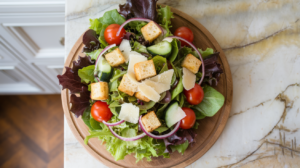This article explores what are the most common ingredients in salad, detailing the basics and variations of this versatile dish. Discover the elements that make a great salad.
Understanding Salad Basics
To understand what are the most common ingredients in salad, it’s helpful to look at the structure of a typical salad. There are a few key categories. Let’s dive into them.
The Core Components
Firstly, there are some common elements found in most salads. These form the base and provide the main nutrients. We will explore these fundamental components.
Why Ingredients Matter
Secondly, each ingredient contributes to the overall taste, texture, and health benefits. Knowing what are the most common ingredients in salad will help you create balanced meals. Therefore, understanding these components is key.
The Foundation of Most Salads: Greens
The base of any salad is often the greens. They provide the bulk and essential nutrients. What are the most common ingredients in salad starts with the greens.
Lettuce Varieties
There are many types of lettuce used in salads. These include romaine, iceberg, butter lettuce, and spring mix. Each offers a different texture and taste.
Spinach and Arugula
Spinach and arugula are also popular choices. They provide a slightly more peppery taste and are packed with nutrients. Therefore, these greens offer extra nutritional benefits.
Other Leafy Greens
Other leafy greens such as kale, collard greens, and endive are sometimes used. They provide a wide range of flavors and textures. They can also add variety to your salads.
Essential Vegetables in Salads
Vegetables are a crucial component. They add flavor, crunch, and important nutrients. What are the most common ingredients in salad often includes a variety of vegetables.
Tomatoes and Cucumbers
Tomatoes and cucumbers are very common. They add freshness and moisture to the salad. They are also readily available throughout the year.
Carrots and Bell Peppers
Carrots and bell peppers provide color and crunch. They also offer extra vitamins and antioxidants. These additions are beneficial for your health.
Onions and Radishes
Onions and radishes add a sharp flavor. They add a unique taste and crispness to the salad. They are also easy to incorporate.
Protein Additions to Salads
Protein is a great addition to make salads more filling. What are the most common ingredients in salad that provide protein? Let’s take a look.
Chicken and Turkey
Grilled or baked chicken and turkey are popular choices. They provide lean protein and a satisfying meal. They are also a versatile option.
Eggs and Cheese
Hard-boiled eggs and cheese are also frequently used. They add protein and different flavors. They are also easy to incorporate.
Beans and Legumes
Beans and legumes like chickpeas, black beans, or lentils can provide plant-based protein. These are great additions for those avoiding animal products.
Dressings and Sauces in Salads
Dressings enhance the flavor and texture. What are the most common ingredients in salad often includes a sauce or a dressing.
Vinaigrette
Vinaigrette is a classic choice made with oil and vinegar. It is light and flavorful. It can also be customized.
Creamy Dressings
Creamy dressings like ranch or Caesar are also popular. They are rich and satisfying. However, they tend to be higher in calories.
Other Sauces
Other sauces, such as tahini or honey-mustard, are often used. They offer a variety of flavors. Therefore, they can change the salad experience.
Adding Crunch and Texture to Salads
Texture is essential. It adds to the overall appeal. What are the most common ingredients in salad for added texture?
Croutons and Nuts
Croutons and nuts provide a satisfying crunch. They also add different flavors and textures. These can improve the overall appeal of the salad.
Seeds and Grains
Seeds such as sunflower or pumpkin seeds and grains like quinoa add texture and nutrients. They also provide added health benefits.
Crispy Vegetables
Adding crispy vegetables like bell peppers can enhance texture. Therefore, these provide both crunch and nutrients.
Fruits for a Sweet and Savory Balance
Fruits can add sweetness to salads. They also provide essential nutrients. When thinking about what are the most common ingredients in salad, fruits are often overlooked.
Berries and Grapes
Berries and grapes are a popular choice for a touch of sweetness. They are also a good source of antioxidants. They can make the salad more appealing.
Apples and Pears
Apples and pears add a crisp texture and a mild sweetness. They pair well with other savory ingredients. These additions add variety to the dish.
Citrus Fruits
Citrus fruits such as oranges or grapefruits add a tangy note. They also provide vitamin C. These fruits make salads more refreshing.
How to Select the Best Ingredients for Your Salad
Knowing what are the most common ingredients in salad is useful. However, it’s important to select quality ingredients.
Freshness Matters
Fresh ingredients make a huge difference. Choose produce that is firm, vibrant, and free from blemishes. Therefore, the freshest ingredients enhance the salad.
Seasonal Produce
Selecting seasonal produce will ensure better flavors and textures. It is also often more affordable. In addition, it will be more environmentally friendly.
Local Sourcing
Local sourcing can also provide fresher, more flavorful options. It can also support your local farmers. Therefore, look out for locally sourced ingredients.
Preparation Tips for Salad Ingredients
Proper preparation is important. It will improve the taste and texture of your salad.
Washing and Drying
Always wash and dry your produce thoroughly. This will remove dirt and bacteria. It will also make sure the dressing adheres properly.
Chopping and Slicing
Chop or slice your ingredients into uniform sizes. This will make the salad more enjoyable to eat. It also ensures even distribution.
Storing Prepared Ingredients
Store prepared ingredients in the refrigerator separately. This will keep them fresh until ready to use. Therefore, proper storage is very important.
Creating a Balanced Salad
Understanding what are the most common ingredients in salad will help you create a balanced dish. A good salad should have a combination of textures, tastes, and nutrients.
Balancing Flavors
Balance sweet, savory, and tangy flavors in your salad. This will make the salad more exciting to eat. Therefore, focus on having a balance.
Nutrients and Variety
Include a variety of ingredients for a good balance of nutrients. This will enhance the nutritional value of the salad.
Experimenting with Ingredients
Don’t be afraid to experiment. You can also try new ingredients. You will discover new combinations you enjoy. Therefore, always try something new.
Conclusion: The Versatility of Salad Ingredients
In conclusion, understanding what are the most common ingredients in salad is the first step to making delicious and nutritious meals. With various greens, vegetables, proteins, and toppings, the possibilities are endless. It offers endless possibilities for creativity. Therefore, salads offer a versatile and satisfying meal option.
Frequently Asked Questions (FAQs)
What are the main ingredients for chicken salad?
The main ingredients for chicken salad typically include cooked chicken, mayonnaise, celery, and seasonings such as salt and pepper. However, variations exist with additions like onions, pickles, or other herbs. The core of chicken salad, though, remains the combination of chicken, mayonnaise, and a bit of crunch, which provides its classic flavor and texture. The specific preparation and ratios of these ingredients can vary widely based on personal preference and regional influences.
Is chicken salad actually healthy?
Whether chicken salad is healthy depends largely on the specific ingredients and portion sizes used. Generally speaking, chicken salad made with grilled or baked chicken breast, light mayonnaise, and a variety of vegetables such as celery, onions, and bell peppers can be part of a healthy diet. However, using full-fat mayonnaise, processed chicken, and neglecting portion control can result in a high-calorie, high-fat dish. Therefore, it’s crucial to be mindful of the ingredients and enjoy it in moderation.
Why is my chicken salad so dry?
A dry chicken salad often results from using too little mayonnaise or having chicken that is overly dry. In addition, if you let the chicken cool in the refrigerator uncovered, it will dry out. Also, certain types of chicken can absorb more moisture. Therefore, to correct it, try adding a small amount of mayonnaise or another moistening agent like plain Greek yogurt, until it reaches your desired creamy consistency. Make sure to add it gradually to avoid making it too wet.
What are the four 4 components of salad?
The four primary components of a salad are the base, the body, the dressing, and the additions. The base is usually made of leafy greens, such as lettuce or spinach. The body includes the main ingredients of the salad, such as protein (like chicken or beans), vegetables, or fruits. The dressing enhances the flavor and also provides moisture to the salad. Lastly, the additions can include toppings like nuts, cheese, seeds, or croutons. All of these contribute to its flavor, texture, and nutritional value, creating a well-rounded dish.
Simple Recipe: Classic Garden Salad
Ingredients:
-
Mixed Greens: 5 ounces (such as romaine, spinach, or spring mix)
-
Cherry Tomatoes: 1 cup, halved
-
Cucumber: 1/2, sliced
-
Carrot: 1 medium, peeled and shredded
-
Bell Pepper: 1/2, sliced (any color)
-
Red Onion: 1/4, thinly sliced
-
Croutons: 1/2 cup
-
Your Favorite Salad Dressing: 2-3 tablespoons (vinaigrette or ranch work well)
Step-by-Step Instructions:
-
Prepare the Greens: Thoroughly wash and dry the mixed greens. Place the greens into a large salad bowl. Make sure the greens are completely dry for best results.
-
Prepare the Vegetables: Wash the cherry tomatoes, halve them, and place in the salad bowl. Wash and slice the cucumber. Add the sliced cucumber to the bowl. Peel and shred the carrot using a grater. Place the grated carrot in the bowl. Slice the bell pepper and add to the salad bowl.
-
Add Red Onion: Thinly slice the red onion. Add this to the bowl as well. Be sure to slice the red onion very thinly.
-
Combine Ingredients: Gently combine all of the ingredients, making sure the vegetables and greens are evenly mixed in the bowl.
-
Add Croutons: Sprinkle the croutons on top of the salad. Add these just before serving. This will help keep them from getting soggy.
-
Dress the Salad: Pour your favorite salad dressing over the salad. Toss lightly to ensure the dressing coats all the ingredients. Use enough dressing to moisten but not drown the salad.
-
Serve Immediately: Serve the salad immediately. Enjoy the fresh mix of greens, vegetables, croutons, and dressing.
Essential Tips and Tricks:
-
Dry Greens: Thoroughly dry your greens after washing. This prevents the salad from being watery. You can use a salad spinner for this step.
-
Vegetable Prep: Prepare vegetables just before assembling the salad. This will ensure they are fresh and crisp. Therefore, prepping veggies last minute is ideal.
-
Dressing Timing: Add the dressing just before serving. This will prevent the salad from becoming soggy. Only add dressing when you are ready to eat.
-
Crouton Crispiness: Add croutons right before serving to keep them crispy. This will enhance the texture of the salad. Therefore, do not add them too early.
Experimenting with Flavors
-
Cheese Additions: Add some feta, goat cheese, or parmesan. This will give a rich flavor and also more protein. Therefore, you can add your favorite cheese.
-
Protein Boost: Add grilled chicken, chickpeas, or hard-boiled eggs. This will make it more filling and also add extra protein. Therefore, consider adding some of your favorite protein.
-
Herb Enhancements: Add fresh herbs like basil, parsley, or mint. These options will give your salad a fresh flavor and aroma. You can customize it to your liking.
Nutritional Information
Nutritional Content (per 100g, approximate)
| Nutrient | Amount (Approx.) |
|---|---|
| Calories | 40-70 kcal |
| Fat | 2-4g |
| Saturated Fat | 0.5-1g |
| Cholesterol | 0-5mg |
| Sodium | 20-40mg |
| Carbohydrates | 5-8g |
| Fiber | 2-3g |
| Sugar | 2-4g |
| Protein | 1-2g |

